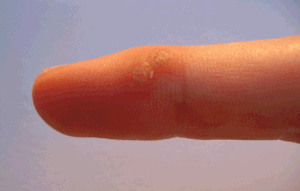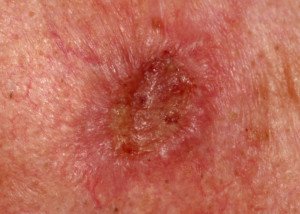
Can a wart on your hand or finger ever transform into melanoma, a deadly skin cancer?
To put this another way, does the mere existence of wart tissue make it more likely that the pigment cells – called melanocytes – in that area will undergo a DNA mutation that will lead to melanoma?
Just what is a wart?
A wart is a benign growth on the top layer (epidermis) of the skin. The growth is caused by an excess amount of a hard protein called keratin.
Excess amounts of this hard substance result in a hard, rough bump that we call a wart.
Thus, a wart involves excess keratin, rather than proliferation of melanocytes, which is what happens in melanoma.
But this still begs the question: Can the existence of a wart, in and of itself, make it easier for melanocytes in the skin of that wart to start proliferating towards a malignancy?
“A wart could turn into a melanoma because a wart is a lesion on the skin,” says Dina D. Strachan, MD, a board certified dermatologist, and founder/director of Aglow Dermatology in Manhattan, NY.
In other words, a wart contains skin. And skin contains melanocytes. And melanocytes can mutate into melanoma.
But NOT because the wart is there. It’s because the melanocytes are there. However, there’s still a few problems that must be considered.
Dr. Strachan continues, “Warts are benign lesions. Warts can, however, become cancerous.
“Warts are more likely to become squamous cell carcinomas than melanomas.
“Warts are caused by the human papilloma virus (HPV) which has many strains. Many are familiar with the association between HPV and cervical cancer.
“HPV can also induce cancer, specifically squamous cell carcinoma, in other organs including the skin.”
So that’s the first issue to consider: A wart may be benign, but the HPV presence can be a component of a malignant transformation into squamous cell carcinoma, which isn’t as deadly as melanoma, but can still metastasize and be fatal if not treated early.
There’ve been studies on the association of HPV and genital warts, but there is no determination of what percentage of hand or finger warts eventually become squamous cell carcinoma.
Next, “As a wart occurs in the skin, however, other types of cancer, such as melanoma, could also occur in skin that has developed a wart,” says Dr. Strachan.
The wart is coincidentally near the development of the melanoma. This creates a problem because the wart can conceal the appearance of an early melanoma.
During a self-skin exam, a person may notice the wart, even acknowledging that it’s been there for a long time, and not inspect it closer, or, they may indeed inspect it, but not notice a small change from a melanoma within it.
If you notice what you believe is a new wart, you should have a dermatologist inspect it and get it treated accordingly.
 Dina D. Strachan, MD, is a board certified dermatologist, consultant and speaker in New York City. She is the founder and director of Aglow Dermatology, an independent medical and cosmetic dermatology practice in Manhattan. Follow her on Instagram and LinkedIn @drdinamd.
Dina D. Strachan, MD, is a board certified dermatologist, consultant and speaker in New York City. She is the founder and director of Aglow Dermatology, an independent medical and cosmetic dermatology practice in Manhattan. Follow her on Instagram and LinkedIn @drdinamd.
 Lorra Garrick has been covering medical, fitness and cybersecurity topics for many years, having written thousands of articles for print magazines and websites, including as a ghostwriter. She’s also a former ACE-certified personal trainer.
Lorra Garrick has been covering medical, fitness and cybersecurity topics for many years, having written thousands of articles for print magazines and websites, including as a ghostwriter. She’s also a former ACE-certified personal trainer.
.









































